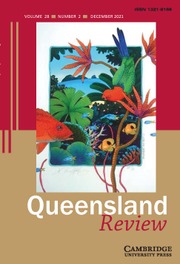Little-known and under-researched aspects of Queensland's history are the focus of the second issue of the twentieth anniversary volume of Queensland Review.
The opening article transports us back 125 years to 1888, when opposition in Queensland to the Colonial Secretary's appointment of a new governor created ripples throughout the empire. Jennifer Harrison's article, ‘“Pitchforking Irish coercionists into colonial vacancies”: The case of Sir Henry Blake and the Queensland governorship’ examines the tensions between the perceived rights of the colony and the high-handedness of its British overlords — a tension mitigated but not resolved by Sir Henry Blake's resignation.
Ray Kerkhove explores a very different aspect of colonial Queensland in ‘Aboriginal trade in fish and seafoods to settlers in nineteenth-century South-East Queensland: a vibrant industry?’. Studies on Aboriginal trade in nineteenth century Australia have focused on the impact of European goods, while goods given in exchange have received less attention. Kerkhove finds evidence for considerable trading of fish and other sea foods in South-East Queensland during the nineteenth century, and offers a reconstruction of the mechanisms that made this trade possible.
Between 1870 and 1950, many Australians engaged in the ancient practice of using water for healing. Peter Griggs's article, ‘“Taking the waters”: mineral springs, artesian bores and health tourism in Queensland, 1870–1950’, identifies six places in Queensland that were visited by persons seeking relief from various medical complaints, including tuberculosis, rheumatism, arthritis, gout, insomnia and digestive problems. Interest in ‘taking the waters’ waned in Queensland after 1945, but a belief in the healing power of water high in mineral content has persisted to this day.
Joanne Scott's contribution, ‘“A permanent and prominent feature of the show”: the origins and meanings of a district exhibits competition’, investigates the beginning, development and popularity of the district exhibits competition at the Brisbane Exhibition — Queensland's major agricultural show. First held in 1891, the contest quickly established itself as a central feature of the Exhibition (colloquially known as the Ekka), presenting a narrative of progress and plenty. Although the original rationale for the competition no longer exists, and despite major changes in Queensland society, the district exhibits have maintained their status across more than 120 years. Through her analysis of the history of the district exhibits and reasons behind the contest's longevity, Scott contributes to our understanding of the values that have helped to shape our community.
In a report on Australian libraries published in 1935, Carnegie Corporation consultant Ralph Munn wrote that ‘anyone wishing to carry away a favourable impression [of the Queensland Public Library] should never make the mistake of entering it’, and dismissed the rural libraries in the state as poor and ‘not sufficiently strong to serve their communities properly.’ In ‘What Munn missed: Queensland's Schools of Arts’, Robin Wagner observes that Munn spent barely two days in Queensland, visiting only a handful of libraries in Brisbane and its immediate environs. Through an analysis of the responses by Queensland Schools of Arts to the survey of Australian libraries conducted by Ralph Munn and Ernest Pitt, Wagner shows that Munn failed to recognise the importance of the Queensland Schools of Arts to the communities in which they were located.
‘Influencing the modern in Brisbane: Gertrude Langer and the role of newspaper art criticism’ by Judy Hamilton considers Dr Gertrude Langer's influence on the production and perception of art in Brisbane. A refugee from Hitler's Europe, with no prospects of employment in the field of art history, Langer took the initiative and conducted salon-style lectures in her home. In the 1940s, she influenced the development of the young artists who established the Miya Studio, Brisbane's first cooperative art studio, and from 1953 to her death in 1984, she used her art criticism column in the Courier-Mail as a public platform to educate the public about how to view art in such a way as to make visiting an exhibition a more rewarding experience.
Brisbane's infamous Boggo Road Gaol, which operated between 1883 and 1992, is the subject of the final article in this issue. ‘If these walls could speak: a visual ethnography of graffiti at Boggo Road Gaol’, by Belinda Costanzo, Melissa Bull and Catrin Smith, studies graffiti from the extant sections of the prison to provide insight into the lived experiences of prisoners. The article employs visual ethnographic methodology to triangulate contextualising resources such as newspaper articles, government reports, biographies and institutional records, in addition to the graffiti. This analysis provides a unique historical record of the prison life of Boggo Road's former inmates.


